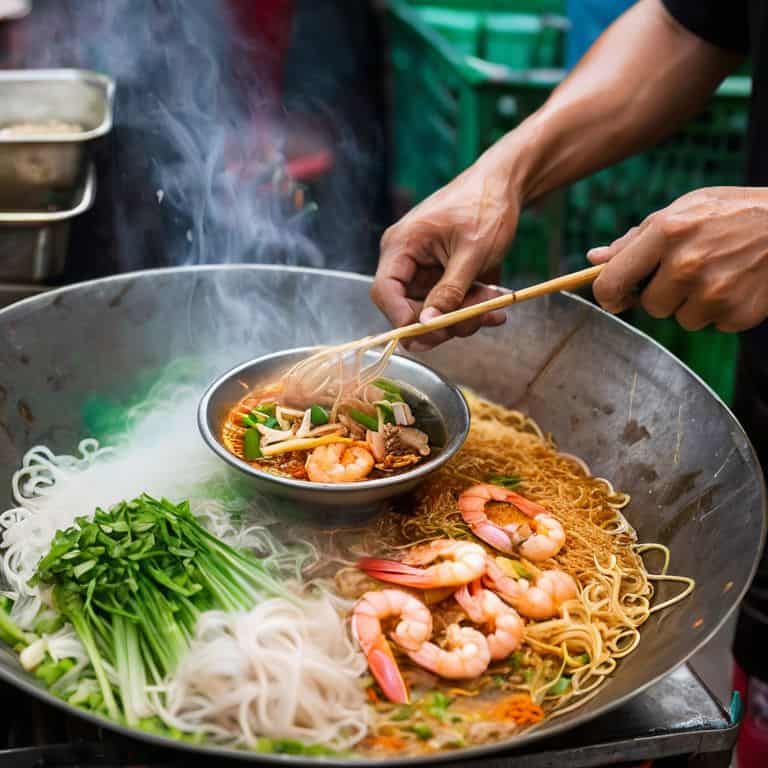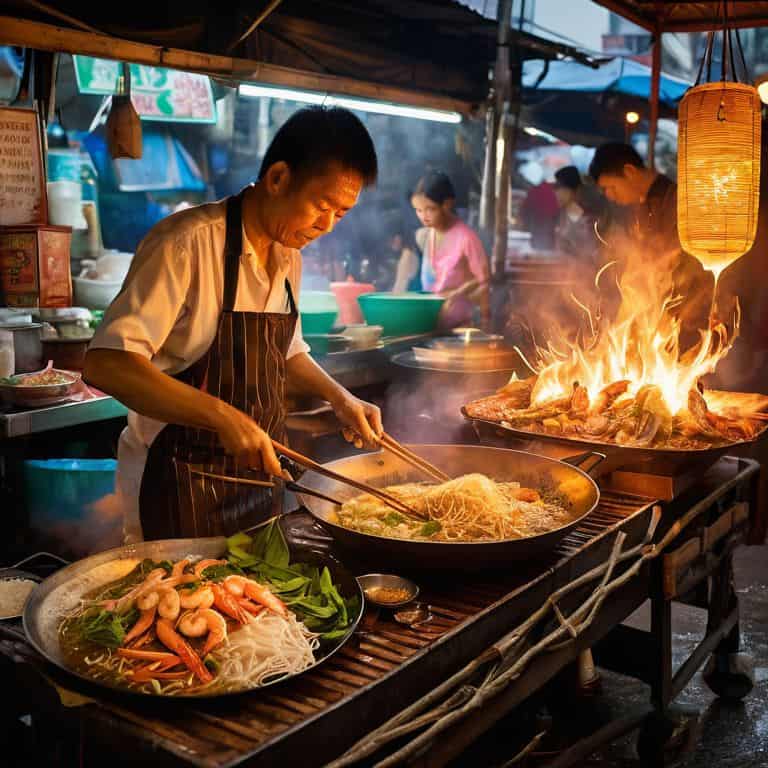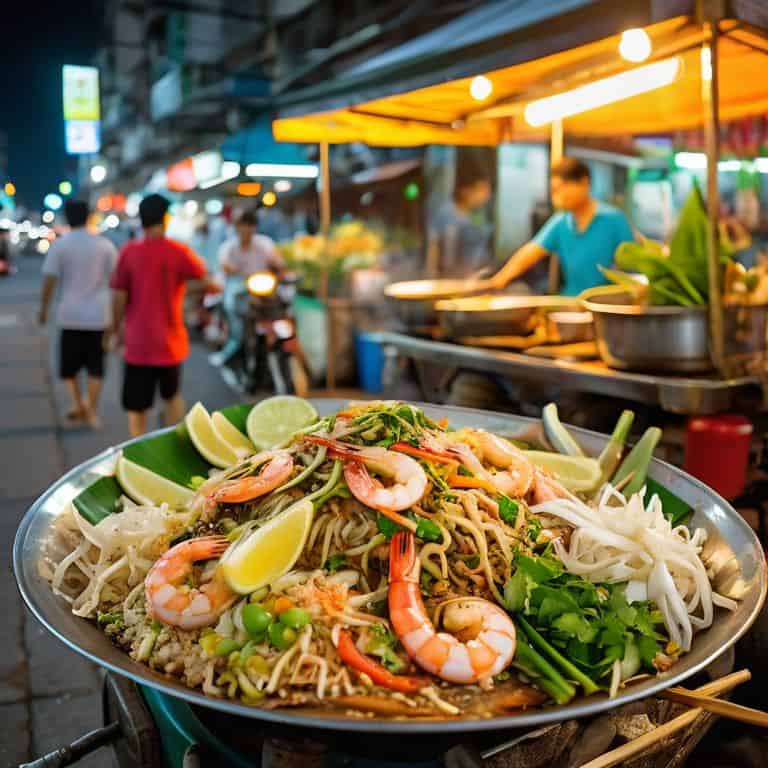I still remember the first time I slurped down a steaming plate of authentic Pad Thai from a street vendor in Bangkok – the combination of sweet, sour, and umami flavors was like a party in my mouth. I was on a mission to learn how to make authentic pad thai, and what I discovered shocked me: most recipes online are just watered-down versions of the real thing. They’ll tell you to use pre-made tamarind paste or skip the crucial step of caramelizing the shallots, but trust me, those shortcuts are a recipe for disaster.
As someone who’s spent years traveling the globe in search of the perfect dish, I’m here to share my hard-earned secrets for making authentic Pad Thai that will transport your taste buds to the bustling streets of Thailand. In this article, I’ll walk you through the step-by-step process of creating this beloved dish, from sourcing the freshest ingredients to mastering the wok-fried noodles. My goal is to empower you with the knowledge and confidence to create a truly authentic Pad Thai experience in your own kitchen, one that will leave you and your loved ones craving for more.
Table of Contents
Recipe Details
Ingredients
- 1 cup rice noodles (preferably fresh)
- 2 tablespoons vegetable oil (for stir-frying)
- 1 onion, thinly sliced
- 2 cloves garlic, minced
- 1 cup mixed vegetables (bean sprouts, carrots, green onions)
- 1 cup cooked shrimp (peeled and deveined)
- 2 tablespoons tamarind paste
- 2 tablespoons fish sauce
- 1 tablespoon palm sugar
- 1 teaspoon ground peanuts
- Salt and pepper to taste
- 2 tablespoons chopped fresh cilantro (for garnish)
- Lime wedges (for serving)
Tools & Supplies
- Large wok or frying pan
- Cutting board
- Chef's knife
- Colander or strainer
- Stirring spoons
- Tongs or spatula
Recipe Instructions
Step 1
First, let’s start with the foundation of a great Pad Thai: the noodle preparation. To achieve the perfect texture, you’ll want to soak 1 cup of rice stick noodles in hot water for about 5-7 minutes, or according to the package instructions. I remember a street vendor in Bangkok telling me that the key is to not over-soak them, as this can make the noodles mushy and unappetizing.
Step 2
While the noodles are soaking, it’s time to prepare the _aromatic ingredients_ that will give our Pad Thai its distinct flavor. Finely chop 2 cloves of garlic, 1 shallot, and 1 cup of fresh bean sprouts. I like to think of this step as the _sensory awakening_ of the dish, as the smells and textures of these ingredients start to come together.
Step 3
In a large wok or frying pan, heat 2 tablespoons of vegetable oil over medium-high heat. Once the oil is hot, add the chopped garlic and shallot, and stir-fry until they’re lightly browned and fragrant. This is the point where the _magic happens_, and the flavors start to meld together in a way that’s both familiar and exotic.
Step 4
Next, add 1 cup of mixed vegetables, such as shredded carrots, diced bell peppers, and sliced mushrooms, and stir-fry for about 2-3 minutes, or until they’re tender-crisp. I’ve found that the key to a great Pad Thai is to _balance the textures_, so don’t overcook the vegetables – you want them to still have a bit of crunch.
Step 5
Now it’s time to add the cooked noodles, 1/2 cup of _tamarind paste_, 2 tablespoons of fish sauce, 1 tablespoon of palm sugar, and 1/4 teaspoon of ground white pepper to the wok. Stir-fry everything together for about 2-3 minutes, or until the noodles are well coated with the sauce and the flavors have melded together. This is the moment when the dish starts to feel truly _authentic_, like you’re tasting the real deal from a Bangkok street stall.
Step 6
To finish the dish, push the noodles and vegetables to one side of the wok, and crack in 2 eggs. Scramble the eggs until they’re cooked through, then mix everything together. I like to think of this step as the _final flourish_, where all the ingredients come together in a delicious, savory harmony. Serve the Pad Thai hot, garnished with chopped peanuts, lime wedges, and a sprinkle of _fresh cilantro_ – and get ready to transport your taste buds to the bustling streets of Bangkok!
Unlocking Authentic Pad Thai

As I delved deeper into the world of Thai street food, I discovered that authentic Thai cooking methods are what set Pad Thai apart from its Westernized counterparts. The key to a great Pad Thai lies in the balance of flavors, which is achieved by combining the sweetness of palm sugar, the sourness of tamarind, and the saltiness of fish sauce. I remember learning this from a street vendor in Bangkok, who would carefully adjust the seasoning of her pad thai sauce ingredients to get the perfect harmony of tastes.
To achieve a stir fry noodles technique that’s reminiscent of Thai street food, it’s essential to use a wok or a large skillet over high heat. This allows for a quick and even cooking of the noodles, which helps to preserve their texture and prevent them from becoming mushy. I’ve also found that adding a variety of vegetables, such as bean sprouts and carrots, can add depth and freshness to the dish, making it a great vegetarian pad thai option.
For those looking to elevate their Pad Thai game, I recommend experimenting with different types of noodles, such as rice stick noodles or glass noodles. This can add a new dimension to the dish and provide a unique twist on the traditional recipe. By mastering the art of Pad Thai, you’ll be well on your way to creating Thai street food recipes that are sure to impress even the most discerning palates.
Mastering Pad Thai Sauce Ingredients
As I delved deeper into the world of Pad Thai, I discovered that the sauce is the heart and soul of the dish. It’s a delicate balance of sweet, sour, and umami flavors that elevates the entire recipe. I recall a street vendor in Bangkok who generously shared her secret sauce ingredients with me – a combination of tamarind paste, fish sauce, palm sugar, and fresh lime juice. The key, she emphasized, is to use high-quality ingredients and adjust the proportions to taste.
I’ve found that mastering the Pad Thai sauce ingredients is all about experimentation and patience. Don’t be afraid to tweak the ratios of sweet to sour, and add your own twist with ingredients like garlic, ginger, or chili flakes. With practice, you’ll develop a sense of the perfect balance, and your Pad Thai will transport you straight to the bustling streets of Bangkok.
Thai Street Food Recipes Revealed
As I delved deeper into the world of Thai street food, I discovered a plethora of dishes that rivaled Pad Thai in flavor and complexity. From the spicy, sour flavors of Tom Yum soup to the sweet, crunchy texture of Som Tam (papaya salad), each recipe told a story of the country’s rich culinary heritage. I spent hours learning from street vendors and home cooks, eager to unlock the secrets of these beloved dishes.
These recipes, passed down through generations, are more than just a list of ingredients and instructions – they’re a window into the heart of Thai culture. By sharing them with you, I hope to inspire a new wave of culinary exploration, one that goes beyond the familiar confines of Pad Thai and into the vibrant, uncharted territory of Thai street food.
Street Food Secrets: 5 Tips to Make Authentic Pad Thai Like a Bangkok Vendor

- I learned from the masters that using the right type of rice noodles is crucial – look for fresh, thin noodles made from rice flour and water, and soak them in hot water for just the right amount of time to achieve that perfect texture
- Balance is key when it comes to the sauce – I’ve found that combining tamarind, fish sauce, palm sugar, and lime juice in just the right proportions is what sets authentic Pad Thai apart from its imitators
- Don’t overcook the noodles or the vegetables – a good Pad Thai should have a bit of crunch and freshness to it, so stir-fry those bean sprouts and shrimp for just a minute or two, until they’re cooked through but still retain some bite
- A squeeze of fresh lime juice and a sprinkle of toasted peanuts can make all the difference – these are the details that will elevate your Pad Thai from a bland, touristy version to a dish that would make a Bangkok street food vendor proud
- Experiment with different types of protein – while shrimp is traditional, I’ve also had amazing Pad Thai with chicken, tofu, and even grilled pork, so don’t be afraid to get creative and find your own favorite combination
Bringing Bangkok to Your Kitchen: 3 Essential Takeaways
I learned that the key to authentic Pad Thai lies in the balance of its sauce, which is a masterful blend of tamarind, fish sauce, palm sugar, and vinegar – a secret I uncovered from a Bangkok street vendor who shared her family’s recipe with me
Using the right type of rice noodles is crucial; they must be fresh and slightly firm to the bite, not the dried version found in most supermarkets, as I discovered during my culinary journey through Thailand’s bustling markets
Experimenting with various protein sources, such as shrimp, chicken, or tofu, and adding fresh bean sprouts, peanuts, and lime wedges can elevate your Pad Thai game, making each bite a true reflection of the dish’s street food heritage, just as I experienced in the alleys of Bangkok
The Essence of Authentic Pad Thai
To make authentic Pad Thai, you must first understand that it’s not just a recipe, but a reflection of the streets, the culture, and the hearts of the people who cook it – it’s a dish that demands your presence, your patience, and your passion.
Marco Bianchi
Bringing Bangkok to Your Kitchen

As I reflect on my journey to master the art of making authentic Pad Thai, I’m reminded of the vibrant streets of Bangkok, where the sounds, smells, and tastes all come together in perfect harmony. From mastering the Pad Thai sauce ingredients to understanding the importance of using the freshest ingredients, every detail counts when it comes to recreating this beloved dish. By following the recipe and steps outlined in this article, you’ll be well on your way to bringing a taste of Thailand into your own home kitchen. Whether you’re a seasoned traveler or an armchair adventurer, the key to making authentic Pad Thai is to stay true to its street food roots.
So, the next time you’re tempted to reach for a generic cookbook or a fancy restaurant menu, remember that the true magic of cooking lies in the stories and traditions behind each dish. As you sit down to enjoy your homemade Pad Thai, I hope you’ll be transported to the bustling streets of Bangkok, if only for a moment. And who knows? Maybe the flavors and aromas will inspire you to plan your next culinary adventure, whether that’s exploring the hidden gems of your own city or embarking on a journey to discover the authentic tastes of a new and exciting destination.
Frequently Asked Questions
What type of rice noodles are best suited for authentic Pad Thai?
For authentic Pad Thai, I swear by fresh, thin rice noodles, known as ‘sen lek’ in Thai. These delicate strands absorb the bold flavors of the dish perfectly. Look for them at Asian markets or online, and avoid dried or thick noodles, which can alter the texture and taste of this beloved street food classic.
Can I substitute or omit any of the traditional Pad Thai ingredients and still achieve an authentic flavor?
While it’s tempting to substitute or omit ingredients, I’ve found that traditional Pad Thai ingredients are integral to its authentic flavor. That being said, you can experiment with omitting bean sprouts or substituting peanuts with cashews, but be cautious with tampering with the holy trinity of Pad Thai: tamarind, fish sauce, and palm sugar.
How do I achieve the perfect balance of sweet, sour, and umami flavors in my Pad Thai sauce?
For me, the secret to balancing sweet, sour, and umami in Pad Thai sauce lies in the harmony of tamarind, palm sugar, and fish sauce. I learned from a Bangkok street vendor to taste and adjust as I go, adding a squeeze of fresh lime or a drizzle of honey until the flavors sing in perfect unison.
